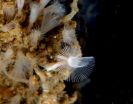(Press-News.org) The horseshoe worm is a worm-like marine invertebrate inhabiting both hard and soft substrates such as rock, bivalve shells, and sandy bottom. The name "horseshoe" refers to the U-shaped crown of tentacles which is called "lophophore." Horseshoe worms comprise a small phylum Phoronida, which contains only ten species decorating the bottom of the oceans.
The new species Phoronis emigi, the eleventh member of the group described in the open access journal ZooKeys, comes after a long 62 year gap of new discoveries in the phylum. It is unique in the number and arrangement of body-wall muscle bundles and the position of the nephridia which is the excretory organ of some invertebrates. The new species is morphologically similar to sand-dwelling species Phoronis psammophila and it is also closely related to Phoronis hippocrepia, which inhabits hard substrate.
The morphology of the topotypes for Phoronis ijimai is also described in this study after 117 years since its original description. The combination of a detailed observation of the internal morphologies and the molecular phylogenetic analyses including the topotypes ensure a synonymy between P. ijimai and the northeastern pacific species Phoronis vancouverensis that has long been disputed.
"It is necessary to use both internal anatomy and molecular data for reveal the global diversity of horseshoe worm. The known phoronid diversity still remains low, with all specimens reported from limited habitats and the localities by the limited reports. Investigations at new localities or habitats may yield additional species in the future", explains Dr Masato Hirose, Atmosphere and Ocean Research Institute, The University of Tokyo, Japan.
INFORMATION:
Original source
Hirose M, Fukiage R, Katoh T, Kajihara H (2014) Description and molecular phylogeny of a new species of Phoronis (Phoronida) from Japan, with a redescription of topotypes of P. ijimai Oka, 1897. ZooKeys 398: 1. doi: 10.3897/zookeys.398.5176
A new species of horseshoe worm discovered in Japan after a 62-year gap
2014-04-04
ELSE PRESS RELEASES FROM THIS DATE:
Math modeling integral to synthetic biology research
2014-04-04
HOUSTON, April 4, 2014 – A long-standing challenge in synthetic biology has been to create gene circuits that behave in predictable and robust ways. Mathematical modeling experts from the University of Houston (UH) collaborated with experimental biologists at Rice University to create a synthetic genetic clock that keeps accurate time across a range of temperatures. The findings were published in a recent issue of the Proceedings of the National Academy of Sciences.
"Synthetic gene circuits are often fragile, and environmental changes frequently alter their behavior," ...
GSA Bulletin: Rock avalanches, ancient weather, astronomical clocks, anoxia, and volcanism
2014-04-04
Boulder, Colo., USA – Highlights from GSA Bulletin articles published online on 20 March through 1 April 2014 include a discussion of a catastrophic rock avalanche in the Atlas Mountains of Morocco 4,500 years ago and that village situated there now; evidence of rain and humidity in ancient soils in the western United States; a contribution to the on-going EarthTime initiative, which is working to refine and calibrate deep time geochronometers; and a call for intensive field studies in volcanic areas.
GSA BULLETIN articles published ahead of print are online at http://gsabulletin.gsapubs.org/content/early/recent; ...
Inspired by moth eyeballs, UC Irvine chemists develop gold coating that dims glare
2014-04-04
Irvine, Calif., April 4, 2014 – All that's gold does not glitter, thanks to new work by UC Irvine scientists that could reduce glare from solar panels and electronic displays and dull dangerous glints on military weapons.
"We found that a very simple process and a tiny bit of gold can turn a transparent film black," said UC Irvine chemistry professor Robert Corn, whose group has created a patterned polymer material based on the findings, documented in recent papers. The postdoctoral associates and students were initially worried when they noticed what appeared to be soot ...
Indoor tanning by teens linked to unhealthy weight control methods
2014-04-04
Philadelphia, Pa. (April 4, 2014) – High school students who use indoor tanning also have higher rates of unhealthy weight control behaviors—such as taking diet pills or vomiting to lose weight, reports a study in the April Journal of Developmental & Behavioral Pediatrics, the official journal of the Society for Developmental and Behavioral Pediatrics. The journal is published by Lippincott Williams & Wilkins, a part of Wolters Kluwer Health.
The association between indoor tanning and unhealthy weight control methods may be even stronger for male than female adolescents, ...
Chemists' work with small peptide chains may revolutionize study of enzymes and diseases
2014-04-04
Chemists in Syracuse University's College of Arts and Sciences have, for the first time, created enzyme-like activity using peptides that are only seven amino acids long.
Their breakthrough, which is the subject a recent article in Nature Chemistry magazine (Macmillan Publishers, 2014), may revolutionize the study of modern-day enzymes, whose chains of amino acids usually number in the hundreds, and of neurological diseases, such as Alzheimer's, which are usually characterized by small clumps of misshaped proteins called amyloids.
Their finding also supports the theory ...
Panel issues exercise recommendations for people with osteoporosis and spine fractures
2014-04-04
Today, experts from the Too Fit to Fracture Initiative presented the results of an international consensus process to establish exercise recommendations for people with osteoporosis, with or without spine fractures. The results were presented at the World Congress on Osteoporosis, Osteoarthritis and Musculoskeletal Diseases in Seville, Spain.
Using the Grading of Recommendations Assessment, Development and Evaluation (GRADE) method, the international multidisciplinary panel examined literature on exercise effects on: 1) falls, fractures, BMD, and adverse events for individuals ...
Does too much time at the computer lead to lower bone mineral density in adolescents?
2014-04-04
Results of a study presented today at the World Congress on Osteoporosis, Osteoarthritis and Musculoskeletal Diseases, showed that in boys, higher screen time was adversely associated to bone mineral density (BMD) at all sites even when adjusted for specific lifestyle factors.
The skeleton grows continually from birth to the end of the teenage years, reaching peak bone mass – maximum strength and size– in early adulthood. Along with nutritional factors, physical activity can also greatly impact on this process. There is consequently growing concern regarding the possible ...
Antioxidants can protect against omega 6 damage -- or promote it
2014-04-04
SAN DIEGO — Given omega 6 fatty acid's reputation for promoting cancer — at least in animal studies — researchers are examining the role that antioxidants play in blocking the harmful effects of this culprit, found in many cooking oils. After all, antioxidants are supposed to prevent DNA damage. But employing antioxidants could backfire, say researchers at Georgetown Lombardi Comprehensive Cancer Center.
In their study, being reported at the AACR Annual Meeting 2015, researchers found that vitamin E actually increased specific damage linked to omega 6 fatty acids. The ...
Light-activated neurons from stem cells restore function to paralyzed muscles
2014-04-04
A new way to artificially control muscles using light, with the potential to restore function to muscles paralysed by conditions such as motor neuron disease and spinal cord injury, has been developed by scientists at UCL and King's College London.
The technique involves transplanting specially-designed motor neurons created from stem cells into injured nerve branches. These motor neurons are designed to react to pulses of blue light, allowing scientists to fine-tune muscle control by adjusting the intensity, duration and frequency of the light pulses.
In the study, ...
UN climate report: Pricing of CO2 emissions critical
2014-04-04
Despite climate change, most polluters still pay little or nothing when they release carbon dioxide into the atmosphere.
'A cost USD 0.15 per kilo CO2 would be enough to solve the whole climate change problem,' says Thomas Sterner, professor of environmental economics at the University of Gothenburg. Sterner is the only Swedish researcher to serve as a coordinating lead author of a new report that the Intergovernmental Panel on Climate Change will present next week.
The third part of Intergovernmental Panel on Climate Change's fifth assessment report, Working Group ...




